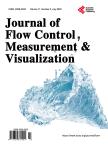Flow Visualization of Multi-Hole Film-Cooling Flow under Varying Freestream Turbulence Levels
Flow Visualization of Multi-Hole Film-Cooling Flow under Varying Freestream Turbulence Levels作者机构:Department of Mechanical and Aerospace Engineering West Virginia University Morgantown WV USA
出 版 物:《Journal of Flow Control, Measurement & Visualization》 (流量控制、测量及可视化(英文))
年 卷 期:2016年第4卷第1期
页 面:13-29页
学科分类:080704[工学-流体机械及工程] 080103[工学-流体力学] 08[工学] 0807[工学-动力工程及工程热物理] 0801[工学-力学(可授工学、理学学位)]
主 题:Film Cooling Flow Visualization Heat Transfer Gas Turbines Turbulence
摘 要:A flat plate film cooling flow from a multi-exit hole configuration has been numerically simulated using both steady and unsteady Reynolds Averaged Navier Stokes (RANS and URANS) Computational Fluid Dynamics (CFD) formulations. This multi-exit hole concept, the Anti-Vortex Hole (AVH), has been developed and studied by previous research groups and shown to mitigate or counter the vorticity generated by conventional holes resulting in a more attached film cooling layer and higher film cooling effectiveness. The film cooling jets interaction with the free stream flow is a long studied area in gas turbine heat transfer. The present study numerically simulates the jet interaction with the multi-exit hole concept at a high blowing ratio (M = 2.0) and density ratio (DR = 2.0) in order to provide a more detailed, graphical explanation of the improvement in film cooling effectiveness. This paper presents a numerical study of the flow visualization of the interaction of film cooling jets with a subsonic crossflow. The contour plots of adiabatic cooling effectiveness were used to compare the multi-exit hole and conventional single hole configurations. The vortex structures in the flow were analyzed by URANS formulations and the effect of these vortices on the cooling effectiveness was investigated together with the coolant jet lift-off predictions. Quasi-Instantaneous Temperature Isosurface plots are used in the investigations of the effect of turbulence intensity on the cooling effectiveness and coolant jet coverage. The effect of varying turbulence intensity was investigated when analyzing the jets’ interaction with the cross flow and the corresponding temperatures at the wall. The results show that as the turbulence intensity is increased, the cooling flow will stay more attached to the wall and have more pronounced lateral spreading far downstream of the cooling holes.



